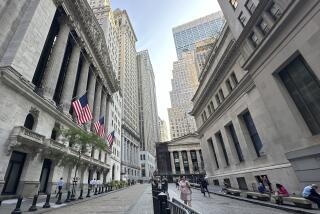Surge in New Issues Worries Wall Streeters
- Share via
No one paid much attention, but the New York Stock Exchange crossed a milestone earlier this year: The number of shares outstanding from NYSE-listed companies topped the 100-billion mark for the first time.
As recently as 1985, NYSE companies had just 50 billion shares on the market. Between then and now, of course, many new companies have been created, and many established companies have sold additional shares or split their stocks to dramatically increase the number of shares outstanding.
Even accounting for all of the shares that disappeared in the takeovers and corporate stock buybacks of the 1980s, the number of NYSE shares outstanding now is triple the figure of 1980--a good barometer of investors’ love affair with the stock market.
But lately the supply of new shares hitting the market has become so huge that it threatens to overwhelm institutional and individual buyers alike, some analysts worry. Investors have done a remarkable job sopping up a vast array of new stocks this year, but many potential buyers are now either out of cash or experiencing a kind of “buyer’s fatigue.”
Shelby Davis, a veteran investor who manages the New York Venture mutual fund, believes that a major reason some big-name growth stocks have inexplicably plunged this year is because many investors have been forced to sell other stocks to find the money to buy new offerings. “I think it’s taking away from last year’s favorites,” he says, and that’s not normally a healthy trend.
It’s true that some companies that had planned to sell stock have wisely pulled back in recent weeks, as investors have balked. Yet some experts believe that the supply of new shares to be offered will have to decrease much further, or there is a risk that it will spark another broad market slump--simply because supply and demand are so out of whack.
Here’s why some pros worry:
* Already this year, 230 companies selling stock for the first time (initial public offerings, or IPOs) have raised $14.8 billion, according to Securities Data Co. In all of 1991, there were 403 IPOs that raised $25.2 billion. So in just four months this year, the market has already absorbed 59% of what was raised in 1991.
* The number of established firms selling additional shares of stock totals 216 year-to-date, and they’ve raised $14.7 billion. In all of last year, 477 established companies sold $34.5 billion in fresh shares. So this market is also running ahead of last year’s pace.
* The supply of fresh stock in the pipeline from new companies and established firms remains gigantic, led by General Motors’ plan to offer $2 billion in new common shares, potentially the biggest stock sale in U.S. history if it flies.
* Upcoming stock splits at some of the nation’s biggest companies--including Merck, Coca-Cola, Disney and Procter & Gamble--will add massively to the number of shares outstanding. Though stock splits don’t change the dollar value of investors’ holdings, they sometimes encourage profit taking just because share owners believe that they have bigger stakes in their companies and more incentive to peel off a bit.
Drug giant Merck, for example, will split 3 for 1 this month. A shareholder who now owns 100 shares at $148 apiece will own 300 shares worth $49.33 each. The number of Merck shares outstanding will rise from 368 million to 1.16 billion.
Wall Street’s bulls acknowledge that the supply of new shares probably has become too large in too short a time. But Steven Einhorn, investment strategist at Goldman, Sachs & Co. in New York, says the supply-demand imbalance will create only “short-term indigestion” in the market, not a sudden price collapse.
Historically, Einhorn says, “there’s no evidence that (heavy) equity supply has ever ended a bull market.”
What’s more, he adds, though new shares are appearing at a tremendous pace in the 1990s, this is merely the flip side of the takeover-buyback mania of 1984-90 that retired $600 billion in stock. In the ‘80s, companies financed their operations with debt, because that’s what investors wanted to buy. Now, with interest rates down, investors want to own stock--so companies are obliging accordingly, Einhorn notes.
He believes that aging baby boomers in particular haven’t even come close to maxing out in their demand for stock in the ‘90s.
Tom Cashman, who manages the Massachusetts Investors Growth Stock fund in Boston, agrees. Short-term, the supply of new stock may have to dry up a bit, he says. But it won’t take long for investors to return to the feeding trough, Cashman says. “Long-term, the supply and demand situation still looks favorable,” he contends.
Shares Everywhere The number of New York Stock Exchange-listed companies’ shares outstanding crossed the 100-billion mark this year for the first time, a reflection of new listings and increasing stock splits. Latest: 103.3 Source: NYSE / Los Angeles Times
More to Read
Inside the business of entertainment
The Wide Shot brings you news, analysis and insights on everything from streaming wars to production — and what it all means for the future.
You may occasionally receive promotional content from the Los Angeles Times.










